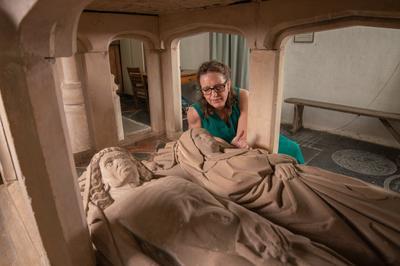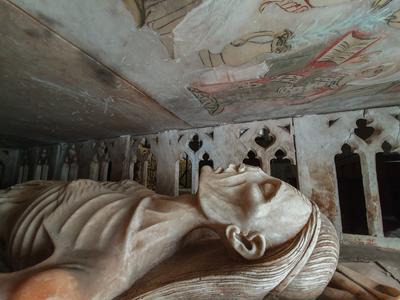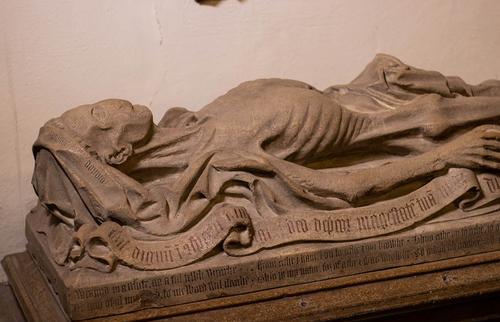English and Welsh Carved Cadavers: An Overview with Dr Christina Welch
To celebrate the upcoming launch of our new documentary Medieval Death: Exploring Cadaver Tombs on January 3rd 2022, Dr Christina Welch has written a fascinating blog article below about carved cadaver monuments.

Carved cadavers (herein CCs) are a Northern European sculpted form of Transi art; Transi meaning ‘passed over’. They were a form of memento mori sculpture reminding all who looked on them that death was inevitable and thus the afterlife should be at the centre of one’s earthly thoughts and deeds. An extract (in translation) from the Latin script that once featured on the CC tomb of Bishop Richard Fleming (d. 1431) in Lincoln Cathedral evidences this:
Stand, seeing in me, who is eaten by worms, what you will be. I, who was once young and beautiful to look on… lie under thick clods. Worldly pomp, honour, recognition, what heights there are, what they, pray, if not dreams, folly? …All things are put to flight by cruel death, like shadows…Brief life is vain, such glory has this end... Through this be wise.
Fleming’s tomb, a tiered CC, juxtaposed a carved effigy of the living bishop dressed in his pontifical robes, with his body at death. The en-vie (in-life) figure conformed to the norms of day; a status symbol memorial that imaged the deceased in garb that emphasised his social position. The en-transi effigy however, showed Fleming in, or arguable at, death. These en-transi effigies typically depicted an emaciated person lying naked on an open burial shroud with a carefully positioned hand to ensure their modesty; i.e.: their genital area was covered.
In England and Wales as the vast majority of CCs are isolated en-transi sculptures (33 of the 44 extant CCs), they were evidently designed to depict something beyond simply commemorating a specific individual. I argue that they portrayed that person in purgatory, the initial afterlife destination for all bar the sainted and the damned according to Roman Catholicism. By the time of the CCs, which started in the late 1390s in France, purgatory had become an increasingly complex theological issue involving both the living and the dead, although the value of praying for the dead in purgatory was only officially adopted by the Church at the Council of Trent (1545-63). The communal economy of prayer during this time is evident from the “pray for me” requests that were common in wills of the time. Effectively, when the living prayed, both for the living and the dead, they were carrying out one of the Seven Spiritual Acts of Mercy and this could help lessen the pains of, and time they spent in purgation; the dead would also benefit from these prayers having their time or pains reduced a little with each prayer. With this mutual relationship between the living and the dead based on the power of prayer, I believe the CCs reminded the living to pray for the dead, especially the commemorated individual but I also suggest CCs also reminded the living to lead a good Christian life, and as such the commemorated individual (whether they commissioned the memorial themselves as several did or whether it was commissioned by their executors), carried out another Spiritual Act of Mercy (to instruct about the faith) and that too was believed to help negate the worst effects of purgation.

The English and Welsh CCs, which probably start around 1415-1420, are unlike many of the Continental CCs which were frequently verminous, showing a decomposing body infested with creatures that represented death and sin such as toads, lizards, and worms. English and Welsh CCs were purely depictions of a naked withered body unadorned with creatures crawling out of their rotting corpse, but regardless of how they looked, all CCs were expensive status symbols and thus were the preserve of the affluent; land-owners, merchants, and senior clerics and as such most are male.
Alice de la Pole (d.1475), the grand-daughter of the poet Geoffrey Chaucer, is the only women commemorated by a CC in Britain. A wealthy land-owner, she commissioned her memorial, choosing to be represented as an emaciated, naked, elderly women with withered breasts. She died soon after her tiered tomb was installed in the church of St Mary the Virgin in Ewelme, Oxfordshire. The CC shows her with half-open eyes so she can see the saints painted in her field of vision. Traces of polychromy (paint) is still evident on her CC, notably some red on her lips, and some brown on her hair.

Conservation work on the isolated CC of the English wool-merchant John Baret (d.1467) in the church of St Mary’s, Bury St. Edmunds, Suffolk (a sculpture commissioned by Baret and erected during his lifetime), shows traces of flesh-coloured paint, and red and green veins on the carved corpse. Thus whilst to us today these CCs may look like they were sculpted to show someone recently deceased, in England and Wales at least, they were carefully crafted to show the person as if still alive, with blood pumping through their veins. As such, I argue these remarkable sculptures resonate with the northern European trope of post-mortem sentience in purgatory, where the pains of purgation were felt physically as well as spiritually, and as such purgatory was somewhere no one would wish to spend much time. They are therefore remarkable sculptures that provide a window into a long-lost way of thinking.
In the new year we'll be making history with the launch of our latest documentary film for our new streaming platform CCTdigital.com
For the first time ever, people will be able to enjoy a feature-length documentary looking at these most bizarre yet fascinating funerary monuments with Dr Christina Welch in 'Medieval Death: Exploring Cadaver Tombs'. We'll take viewers on a transi-trail visiting 10 historic medieval tombs across England with one of the world's leading experts on Cadaver Tombs and Medieval Death - watch the trailer here
During the film we visit churches, a college chapel, and a cathedral exploring the art, history & religious beliefs surrounding these amazing monuments looking at why they were created and what led to their eventual downfall.
The film launches on CCTdigital.com on January 3rd 2022, and is exclusively available for Members to watch. Membership costs from just £3.50 per month, and your money doesn't just gain you access to great content, it helps to save and conserve historic churches! Learn more about the benefits of being a member and join here

